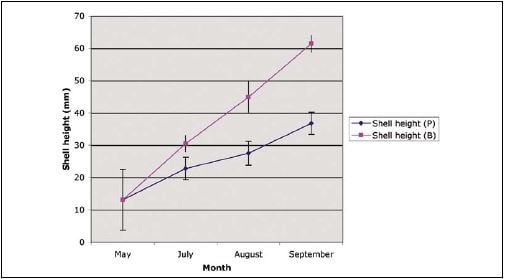5.3 TECHNIQUES – GROWOUT OF JUVENILES
Calico and zigzag scallop juveniles grow quickly at a rate of approximately 5 mm per month. The first few months of growout are therefore labour intensive, in that biomass needs to be regularly controlled to maintain an optimal growth rate. A schedule is given below describing the time between transfers and pearl net size. Once scallops reach a size of approximately 40 mm, at a density of 30 scallops per net, maintenance becomes less labour intensive, involving monthly checks for rips and tears and control of fouling.
5.3.1 Calico scallop growout
Transfer of juvenile scallops to larger size pearl net is conducted on the boat. Large containers of seawater are prepared on board (minimum of two); series of pearl nets are brought on board and scallops removed. Dead scallops are discarded and live animals are transferred to holding containers. Collected scallops are re-distributed into a pearl net of larger mesh size (6 mm) at a density of 75 scallops per net. Series of nets are then re-suspended on longlines. Scallops remain in these nets for a period of one month.
Thereafter, they are transferred to 9 mm nets at a density of 40 scallops per net. They can be maintained up to two months at this density and in this net size; after which they are transferred to 12 mm nets at densities of 30 scallops per net.
Calico scallops average 5 mm per month in shell growth between 3 to 9 months of age; shell growth decreases thereafter allowing for energy utilization during gametogenesis in 10 months old individuals; as spawning period occurs during the winter months (December to May in Bermuda), shell growth remains minimal at this time, but increases once again during the second summer period. Calico scallops have a life span of approximately 2.5 years in Bermuda and can attain a maximal shell height of 65 mm during their second year of growth. The expected growth curve for calico scallops reared on longlines in Bermuda waters is given in Figure 5.8.

Figure 5.8: Shell growth of calico scallop, A. gibbus, juveniles reared on longlines in Bermuda.
For maintenance and control of fouling, monthly checks are made on the longlines. Wear and tear in the line is checked, along with rips in nets. Depending on season and water temperature, nets need to be cleaned monthly (during summer months), and every three months (during winter months). A saltwater power washer (electric motor driven on board) is used for cleaning of nets; it can be connected to the battery of an outboard engine, and nets can be cleaned with scallops remaining inside. This is a much quicker and efficient way of cleaning with no mortality ensued by scallops. Care must be taken to minimize the pressure in order to avoid damaging the scallops when using this method.
5.3.2 Zigzag scallop growout
Zigzag spat are treated in a similar manner to calico scallops until the size of 25 mm.The recessive nature of zigzag scallops seen in Figure 5.9 favours bottom rather than suspended culture (Figure 5.10). These results are in accordance with others reported in the literature, notably the investigation on zigzag scallops by Lodeiros and Himmelman (1994). Thus at 25 mm and above, zigzag

Figure 5.9: Adult zigzag scallops, E. ziczac, showing natural recessive behaviour in the sand.
juveniles are reared directly on the sandy bottom, enclosed by a cage, protecting scallops from predation. This is a much more labour intensive method of rearing, as all labour needs to be conducted by SCUBA diving. Cages are made of 20 mm rebar, and meshed on top and sides with plastic 15 mm to 25 mm mesh depending on size of scallops. The bottom is left open, allowing scallops to recess directly into the sand. Cages are of 2.5x1.5 m, yielding a surface area of 3.75 m2.
The first transfer of 25 mm juveniles to bottom cages (15 mm mesh size) entails the collection of spat from pearl nets. Initial density is of 400 juveniles per cage. Juveniles only remain at such a high density for a period of one month. They then have to be collected by SCUBA, and thinned out to 200 juveniles per cage; again they remain as such for 1-month period, and are then transferred to a 25 mm cage at the final density of 100 per cage. This remains a high density, and periodically, scallops have to be collected and the cage moved. High density of scallops alters the composition of the substrate, leading to hypoxia or anoxia of the sediment, becoming an unfavourable environment for growth. Controlling fouling for cages has to be done monthly by SCUBA using a scrub brush for removal of epiphytes. Although this is intensive, it results in a noticeably faster growth rate than pearl net rearing. The difficulty in commercializing bottom culture lies in developing a time efficient and cost efficient system. To the author’s knowledge, such a system for large scale rearing of the sand scallop has not been developed to date.

Figure 5.10: Comparative growth between zigzag scallops cultured directly on the sandy bottom (B) and suspended in pearl nets (P).